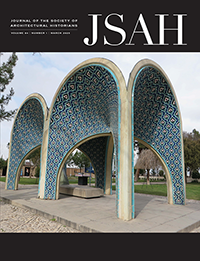Apr 3, 2018
by
Keith Marshall, The Times-Picayune
From the French Quarter's Pontalba Buildings to the Garden District's mansions, many of New Orleans' historic structures are well-loved, postcard-worthy spots that most people could identify on sight. But how much do you know about the architecture and buildings of the Central Business District, Mid-City, City Park, Gentilly, Algiers or other neighborhoods?
A new architecture guidebook offers a comprehensive look at nearly 300 structures, monuments and buildings that contribute to the metro area's rich and varied culture -- from New Orleans to Jefferson Parish to St. Bernard. "Buildings of New Orleans" ($29.95, University of Virginia Press) was co-written by Karen Kingsley and Lake Douglas. It is the second in the "Buildings of the United States" cities series by the Society of American Architectural Historians and the University of Virginia Press.
Though the name refers only to buildings, the book explores other "built environments," including green spaces, monuments and parks. With 175 photographs and 23 maps, it offers a wealth of history and context as well as a concise description of each location. A paperback with a travel guide's relaxed but informative tone, it's organized into neighborhood tours, making it perfect for tossing into a backpack and jumping on a streetcar for a day of architecture exploration.
Kingsley, who taught at Tulane University's School of Architecture for 25 years, is the series editor. She teamed with Douglas, who has authored several previous books, including "Public Spaces, Private Gardens: A History of Designed Landscapes in New Orleans," and is an associate dean and professor of landscape architecture at Louisiana State University.
Both Kingsley and Douglas emphasize that "Buildings of New Orleans" is designed for anyone with an interest in buildings and landscapes, not just architecture buffs.
Reached by email last weekend, the two answered questions about the guide. Responses have been edited for brevity and clarity.
Q: Why is the guide titled "Buildings of New Orleans" instead of "Architecture of New Orleans?"
A: Kingsley: When the series was initiated by the Society of Architectural Historians, the then-editors decided to title the series "Buildings of The United States" because the volumes would include all kinds of structures, including engineered works, and industrial and vernacular architecture, not just high-style buildings as a title "Architecture of......" might suggest. The series was inspired by the renowned architectural historian Nikolaus Pevsner's "Buildings of England," a county-by-county series. The organization of the books is by neighborhoods or areas to make the book convenient for tourists and others.
Douglas: "New Orleans buildings" are the local examples of these styles; they may be similar in content to stylistic examples elsewhere, but with certain characteristics that make them particularly local and sui generis. We wanted this book to include buildings that represent the complete range of 300 years of the city's architecture, from the earliest examples to the most recent.
The guide is notable for its inclusion of industrial buildings and for its coverage of some of the city's controversial monuments and newest green spaces. You even have a picture of the Lee Circle pedestal with the statue of Robert E. Lee removed. Whose idea was it to include such subjects?
Douglas: It was Karen's idea to include parks and open spaces in the New Orleans volume, since they are so much of what characterizes the image of the city. I was happy to be involved in adding to the discussion about architecture by including environments, because I think the environment, considered as a whole to include buildings and their settings, is what defines the city, describes our cultural heritage and makes our community unique.
Kinglsey: In 2003, I published "Buildings of Louisiana" (then-series-publisher Oxford University Press). Since then, much has changed in New Orleans. ... Much of the content of "Buildings of New Orleans" is taken from the New Orleans chapter of the Louisiana volume, but updated to reflect the architectural changes since Hurricane Katrina -- new buildings, additions to building, landscapes, open spaces and such.
Read More 

